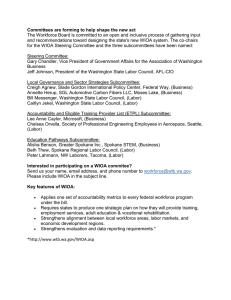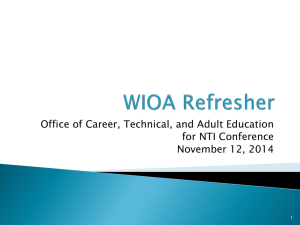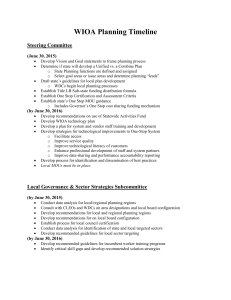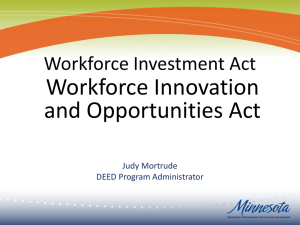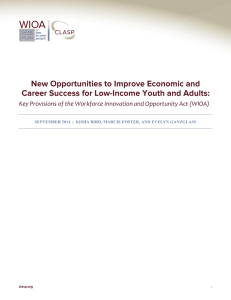Workforce Innovation and Opportunity Act Reform Highlights
advertisement
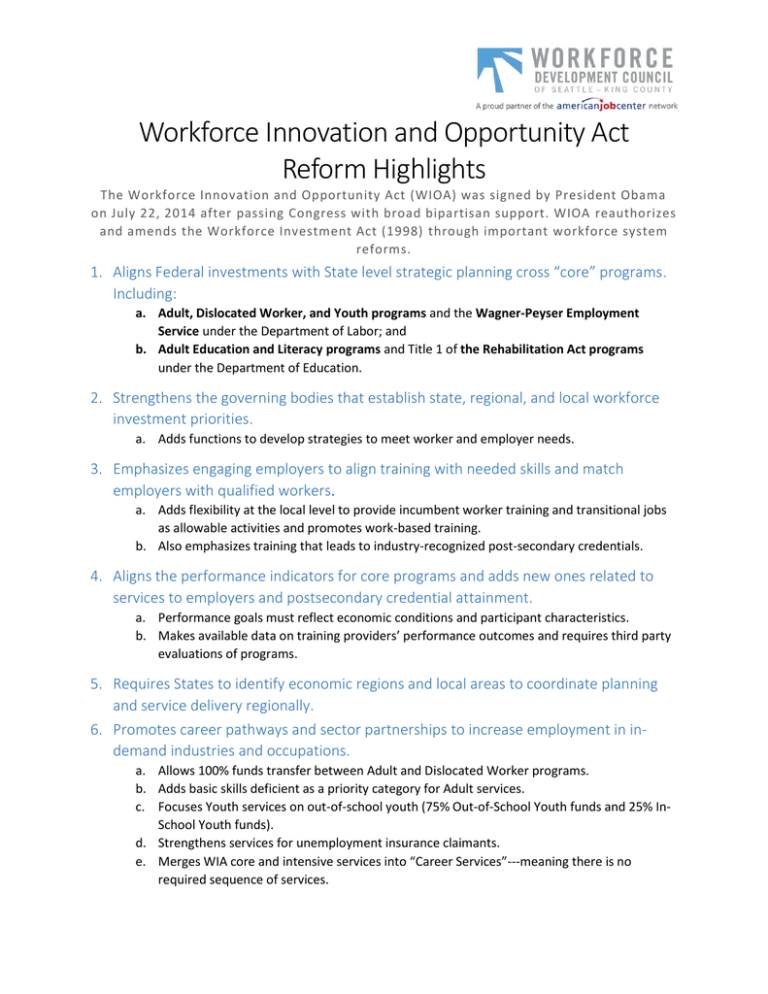
Workforce Innovation and Opportunity Act Reform Highlights The Workforce Innovation and Opportunity Act (WIOA) was signed by President Obama on July 22, 2014 after passing Congress with broad bipartisan support. WIOA reauthorizes and amends the Workforce Investment Act (1998) through important workforce system reforms. 1. Aligns Federal investments with State level strategic planning cross “core” programs. Including: a. Adult, Dislocated Worker, and Youth programs and the Wagner-Peyser Employment Service under the Department of Labor; and b. Adult Education and Literacy programs and Title 1 of the Rehabilitation Act programs under the Department of Education. 2. Strengthens the governing bodies that establish state, regional, and local workforce investment priorities. a. Adds functions to develop strategies to meet worker and employer needs. 3. Emphasizes engaging employers to align training with needed skills and match employers with qualified workers. a. Adds flexibility at the local level to provide incumbent worker training and transitional jobs as allowable activities and promotes work-based training. b. Also emphasizes training that leads to industry-recognized post-secondary credentials. 4. Aligns the performance indicators for core programs and adds new ones related to services to employers and postsecondary credential attainment. a. Performance goals must reflect economic conditions and participant characteristics. b. Makes available data on training providers’ performance outcomes and requires third party evaluations of programs. 5. Requires States to identify economic regions and local areas to coordinate planning and service delivery regionally. 6. Promotes career pathways and sector partnerships to increase employment in indemand industries and occupations. a. Allows 100% funds transfer between Adult and Dislocated Worker programs. b. Adds basic skills deficient as a priority category for Adult services. c. Focuses Youth services on out-of-school youth (75% Out-of-School Youth funds and 25% InSchool Youth funds). d. Strengthens services for unemployment insurance claimants. e. Merges WIA core and intensive services into “Career Services”---meaning there is no required sequence of services. f. Allows Governors to reserve up to 15% of formula funds for activities such as innovative programs. 7. Increases individuals with disabilities’ access to high-quality workforce services to prepare them for competitive integrated employment. a. Requires better employer engagement and promotes physical and programmatic accessibility. b. Youth with disabilities receive extensive pre-employment transition services. c. Creates an Advisory Committee on strategies to increate competitive integrated employment for individuals with disabilities. 8. Requires co-location of Wagner-Peyser Employment Services in American Jobs Centers and adds the Temporary Assistance for Needy Families program as a mandatory partner. a. Sec. of Labor will establish a common identifier for the workforce system to help workers and employers find available services. b. Allows local areas to award pay for performance contracts so providers get paid for results. Source: http://wdr.doleta.gov/directives/attach/TEN/WIOA_Factsheet_Acc.pdf WIOA Important Dates January 18, 2015 Department of Labor (DOL), Department of Education (Ed), and Department of Health and Human Services (HHS) must publish Notices of Proposed Rulemaking to Implement WIOA July 1, 2015 Most WIOA provisions take effect, 1st Program Year begins WIA state and local plan provisions continue to apply for the first full Program Year Current performance accountability system remains in effect for first full Program Year July 22, 2015 Template for performance reports by state, local, and Eligible Training Providers must be developed by Secretary of Labor and Secretary of Education DOL, ED, and HHS must publish Final Rules to Implement WIOA March 2, 2016 Deadline for State Unified Plan submission Levels for new performance indicators negotiated as part of approval for State Unified Plans June 30, 2016 DOL and ED must develop performance indicator relating to effectiveness in serving employers July 1, 2016 One-stop infrastructure cost requirements take effect One-stop delivery identifier must be implemented July 22, 2016 1st plan describing research studies and multistate project priorities for a 5 year period is due Provisions relating to subminimum wages for individuals with disabilities take effect July 22, 2018 Independent evaluation of the programs and activities authorized in WIOA is completed (atleast once every 4 years) Source: http://www.doleta.gov/wioa/pdf/WIOA-Key-Implementation-Dates.pdf Highlights of WIOA Reforms for Adult Education Increases coordination of core programs through submission of a Unified State Plan for core programs, that includes the strategic vision and goals of the state and the operational elements that support the four-year strategy. o o Includes how Adult Education and Family Literacy Act (AEFLA)-specific elements, including: align content standards for adult ed with state-adopted academic standards; fund local activities; use funds to carry out State leadership activities; and assess the quality of education providers. Must submit Unified State Plans by March 2016. Establishes Common Performance Measures across Core Programs that will be negotiated with each State by the Secretaries of Education and Labor. o o Performance measures include: percentage of program participants in unsubsidized employment during the 2nd and 4th quarter after exit; median earnings; percentage of participants who obtain a postsecondary credential or diploma during participation or within one year after exit; participants achieving measurable skill gains; and effectiveness in serving employers. Negotiated as part of Unified State Plan in March 2016. Strengthens alignment between adult education, postsecondary education, and employers. o o Adult education activities should increase an individual’s ability to transition to postsecondary education and obtain employment. Authorizes the use of funds for (concurrently or in combination with other training services): Integrated education and training “Service approach that provides adult education and literacy activities concurrently and contextually with workforce preparation activities and workforce training for a specific occupation or occupational cluster for the purpose of educational and career advancement.” English literacy and civics education programs Workforce preparation activities “Activities, programs, or services designed to help an individual acquire a combination of basic academic skills, critical thinking skills, digital literacy skills, and self-management skills, including competencies in utilizing resources, using information, working with others, understanding systems, and obtaining skills necessary for successful transition into and completion of postsecondary education or training or employment.” Supports educational and career advancement for incarcerated individuals to promote successful reentry and reduce recidivism. o o Increases correctional education funding for states to not more than 20%. Funds may be used for integrated education and training, career pathways, concurrent enrollment, peer tutoring, and transition to re-entry initiatives and other services with the goal of reducing recidivism. Encourages establishment of a high-quality local adult education delivery system with amended considerations. o States should consider when providing funding to local program providers: Increased emphasis on alignment of activities with regional needs identified in local plans under Title I; serving individuals with disabilities; instructional activities based on rigorous research; effective use of technology; activities that promoted integrated education and training; and coordination with education, training, employers, and social service providers. Supports professional development opportunities and innovative models to enhance adult education programs, including new required leadership activities funded through State leadership funds. o State plans should support alignment of core programs through professional development, technical assistance, and evaluation. Promotes activities to improve the quality of adult education programs by ensuring that resources support activities that better prepare adult students for postsecondary and career success. o o WIOA reserves 2% of AEFLA funds to carry out national leadership activities. Secretary should support mandatory technical assistance activities for performance measures and evaluation. Codifies the Integrated Literacy and Civics Education (IEL/CE) program. o o 12% of AEFLA funds will be reserved to carry out the IEL/CE program. Programs should (1) prepare adults who are English language learners for unsubsidized employment in in-demand industries and occupations and (2) integrate with the local workforce development system. Source: WIOA and Overview of Title II compiled by the US Dept of Education The Workforce Development Council of Seattle-King County (www.seakingwdc.org) is a nonprofit workforce “think tank” and grant-making organization that oversees employment-related programs for youth, the adult workforce and employers in King County, with the goal of a strong economy and self-sufficiency for every resident. The Workforce Development Council of Seattle-King County is an Equal Opportunity Employer and provider of employment and training services. Auxiliary aids and services are available upon request to individuals with disabilities. Washington Telecommunications Relay System, 800.833.6384 or 7-1-1.
